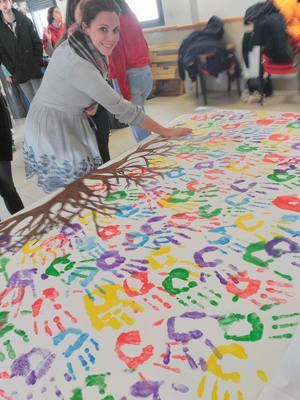1ST ACTIVITY – EUROTRAVELLERS
- PLANNING:
WHAT: Students made a short film about the history of their country. The History Department would support students to develop this activity. Costumes, theatre sets and sceneries were part of the film. The film had a duration of 30 minutes approximately.
WHY: Students would be aware of their own historic background as well as learn about their partners’ history. This activity aimed to promote their creativity at the same time they could reflect on the language as it was English the vehicular way of expression.
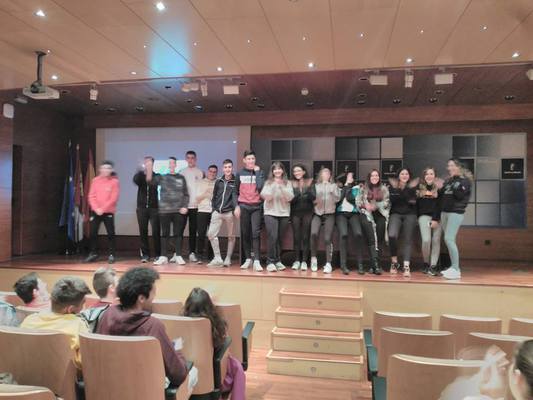
2ND ACTIVITY – TOURIST GUIDES
- PLANNING:
WHAT: Hosting students made a guided tour for the visiting students in the town/city where the school is located. Previously made maps and flyers were handed out during the tour
WHY: By organising this activity students would become aware of their own cultural and historical heritage. We were promoting them to look for specific information and to scan relevant facts about their own city most important sightseeing points. They were fostered to learn how to manage, organise and plan an activity.
- DEVELOPMENT:
Welcome by the mayor of Guadalajara, the Spanish group was the tourist guide around the city of Guadalajara, students’ families invited all of us to a delicious paella.
To start with, the group made up of Carla Alañón, Víctor Lópe, Pablo López, Gema Andújar and Paula Alonso, belonging to Eloísa’ class, presented the planning for the day: to create a guided tour around Guadalajara. ‘Passports’ were handed out to all the students. These ‘passports’ had to be filled with stamps got when visiting or performing several activities along the tour.
The whole group was divided into 5 subgroups so as not interrumpt each other when listening to explanations or moving from one place to another.
Previous to the beginning of the tour, we received a speech at the town hall’s main room and got some gifts from the mayor. After that, we were given a 15 minute break before the guided tour around the city was initiated.
Visited places: Cotilla palace, Concordia Park, Alvarfáñez Tower, Infantado palace. In all of these places students gave a speech with a short story of the place and why it is so important for this city.
3RD ACTIVITY – OLYMPIC GAMES
- PLANNING:
WHAT: Hosting students celebrated The Olympic Games for the visiting students during the transnational exchanges. Using national traditional games as inspiration, they prepared cooperative games for the visiting students. The players in each team had to be from different countries. There would be a tasting of a national dish and a match to be played by the whole of students. As hosters for the Olympic Games, they would shape up aspects related to the Games.
WHY: English skills would be improved by developing this activity, coexistence between partners and real interaction were also enhanced here as well as the inclusion of all students, taking into account participants’ particular needs. Their creativity would be strengthened by making up all the parts and they will bring to them healthy habits.
- DEVELOPMENT:
- The winners of the race walked from the school the Multiusos palace carrying the Olympic torch, followed by all the sport students grouped in countries.
- We had the torch, the pet “Passportin”, the Olympic flame, symbols of each country (Italians were carrying a pizza, Irish a shamrock, Norwegians a salmon, Portuguese a cock…) faces painted with the corresponding colour, the official Olympic games hymn (composed by them and sung by a student), medals for the winners and badges for everyone with the designed provided by the students. Besides this, all the sport challenges carried out.
4TH ACTIVITY – Museum gymkhana
- PLANNING:
WHAT: Hosting students prepared a gymkhana or skill-based contest to be held in one National Museum that all students visited during the student exchange. It would be done in cooperative teams. A guided visit to the city where the Museum would also be held.
WHY: We wanted to install in them the liking for art in general and to appreciate and value the most relevant national artists’ masterpieces. We understood that this spread of national art would make our visiting students have a global understanding of the country idiosyncrasy and cultural heritage. The English language had to be used permanently during the visit, which would make them develop both communicative and social skills.
- DEVELOPMENT:
- ‘Let’s say I’m talking about Madrid’. Again students gathered in groups prepare an amazing gymkhana and some information of the key places like Plaza Mayor, Cibeles fountain…
- What best way of knowing the masterpieces of Prado museum that carrying it out through the famous gymkhana.
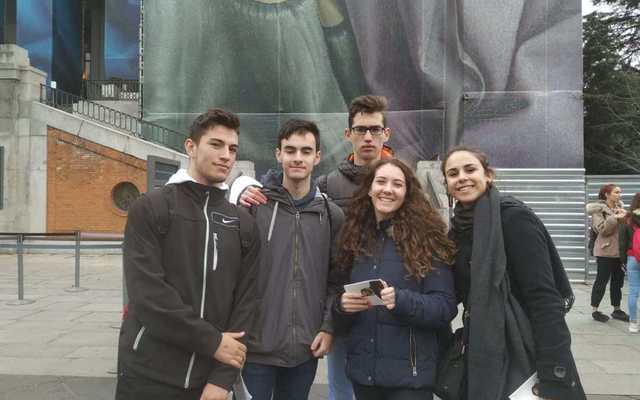
5TH ACTIVITY – CYBERBULLYING
- PLANNING:
WHAT:Hosting students had to design a series of activities to define what cyberbullying is, to explain the responsible use of social networks and to delve into the privacy in the use of social networks. The activities had to be presented to the visiting students during the school exchange and should include short videos and clips made by the students as well as power point presentations and activities raising public awareness on this issue.
WHY: Identify and prevent the major problems brought by the bad use of social networks. Raise Ss awareness of the responsible use of them and become used to peer observing and solving them effectively. In addition, Students would foster their public speaking as they would coach their partners in the transnational meetings.
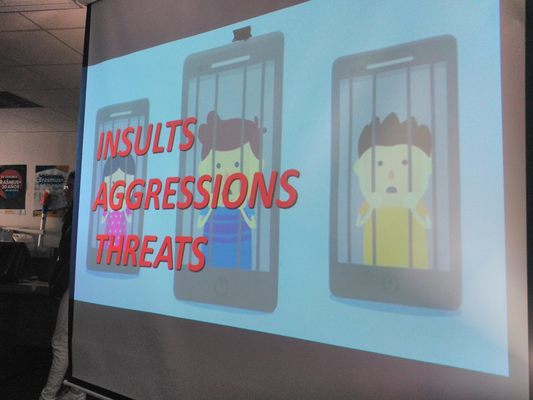
6TH – CHARITY RACE
- PLANNING:
WHAT: Hosting students organized a charity race in the school neighbourhood. They were responsible for tracing the route and calculating the distance covered, as well as getting the police permission. The race would take place during the transnational meeting.
WHY: Coexistence among participants and raising funds for a local NGO or Foundation would be the main aims of this mini-project.
- DEVELOPMENT:
- Students were in charge of preparing the itinerary, designing and requesting numbers, asking for official permission (police, town hall…), designing the t-shirts, being sure that the local police was covering the event…
- Ana Lozano, national and international athlete, attended the event, spoke with the students about the importance of sport and gave the medals to the winners.
- A member of the official committee of athletics group of referees and delegate in Guadalajara, José Luis Oses, collaborated at the goal controlling the students’ arrivals.
- We received several solidary contributions and the money raised was given to the Criscancer association. They are going to build two rooms in the Paz hospital for children with cancer.
7TH ACTIVITY – STEREOTYPES
- PLANNING:
WHY: We wanted our students to be European citizens in its broader meaning, to eliminate myths about other countries, to learn to keep an open mind towards other people, to acquire a global awareness and understanding of other cultures as it fosters a better understanding of the world. They would also use English a real communicative situation.
WHAT: Students make articles and games about stereotypes.
Cultures: All Arabs are terrorists.
We propose different types of stereotypes to work on:
Racial: All black are good athletes.
Gender and sexual: Men are the backbone.
Groups of Individuals: Goths wear in black and are depressed.
- DEVELOPMENT:
- Students had different cards with the name of different countries (Greece, Poland and Spain) which they would use to name the country the meant. Sometimes they had to show, for example, who dances the best? And then, the students had to dance, we ended up all dancing La Macarena and Paquito el Chocolatero…
8TH ACTIVITY – MINDFULNESS
- PLANNING:
WHAT: Each working session dedicated to develop the project Passport to Europe would be started with a five minute session of mindfulness. A session of mindfulness with hosting and visiting students and teachers would take place during the transnational meetings.
WHY:“Mindfulnessisthebasic human ability to be fullypresent, aware of wherewe are and whatwe’redoing, and notoverly reactive oroverwhelmedbywhat’sgoingonaroundus. It’swordless”.
It’s well-known that practising mindfulness regularly can benefit, in this case, our students. It’s great help when focusing and concentrating on studies,they learn easy techniques to help control anxiety in any situation, it reduces stress, it improves self-esteem, and it helps to improve sleep and energy levels.
- DEVELOPMENT:
- Every day of that week, we did mindfulness the very first minutes of every session.
- A external person came to school to carry out the session.
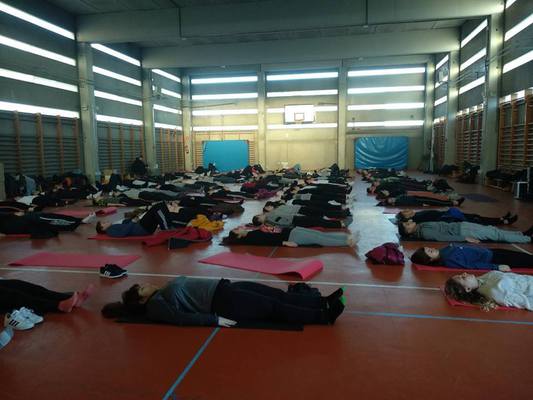
9TH ACTIVITY – GROWING THE SEEDS OF EUROPE
- PLANNING:
WHAT: Students designed and created a class garden. During the transnational meetings, visiting students would bring seeds from typical plants from their countries that would be planted in the hosting students’ gardens.
WHY: One of the key points of the Quality Assessment values the impact the project has on the school. Permanent results to be enjoyed not only by our students but by the whole educational community. The pursued objectives here are to beautify our classes and schools, make the spaces/areas more comfortable for our students, making them feel it is really their place. Areas where to chat, work or just relax.
It would also raise their awareness of care for the school and it would undoubtedly improve the centre /institution coexistence.
- DEVELOPMENT:
- Growing the seeds of Europe. Glorious closing day of the first Transational week of the KA229 project Passport to Europe. Our mates from Skals (Polonia), Iraklio (Greece) and Chania (Greece) were part of a process of knowing, seeding, growing different seeds of the area.
- Spanish students brought the different panels turned into flower pots with recycled wood, they divided the students into mixed groups from different nationalities and they sed the different countries seeds in each of them.
- At the same time, we painted a huge tree-shaped canvas.
